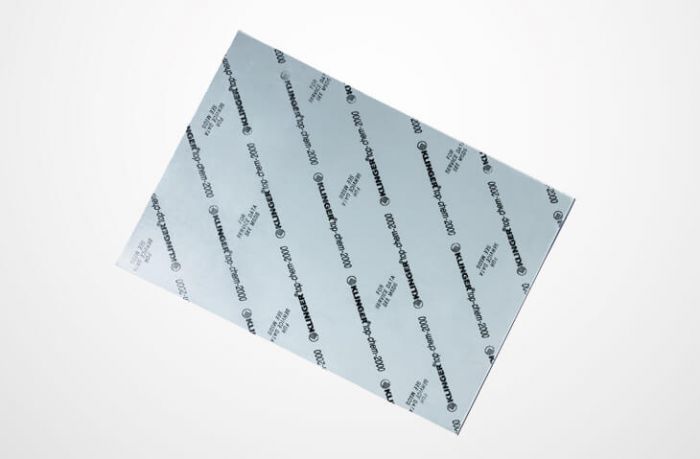
- KLINGER Australia
- Products
- Jointing / Gasket Materials
- PTFE
- KLINGER® top-chem 2000
Products
Need help with a product?
Get in touch
Call 1300 798 279 (from Australia)
+61 8 9251 1688 (outside Australia)
OR send us your enquiry
KLINGER® TOP-CHEM 2000
Exceptional performance at high mechanical requirements.
KLINGER® top-chem 2000 is a universal heavy-duty gasket which offers exceptional performance in applications with high mechanical requirements at high temperatures. This is the only PTFE gasket with a fire-safe-certificate.
Basis
PTFE gasket filled with SiC (Silicon carbide).
Areas of application
Excellent resistance in strongly acidic and alkaline applications as well as steam and oxygen. Suitable for an extremely wide range of applications in the chemical and petrochemical industry, and in the ship building industry for the transport of chemicals.

Key features
- Mechanically stable
- Resistant to creep and cold flow
- Consistent material composition
Benefits
- Resists high surface pressures also at elevated temperatures
- High retention of the bolt load
- Superior chemical resistance
- No ageing of the material
CERTIFICATES & APPROVALS
- DIN-DVGW
- DIN-DVGW W 270
- KTW-Guideline
- German Lloyd
- WRAS approval
- TA-Luft (Clean air)
- Fire-Safe acc. to DIN EN ISO 10497
- FDA conformity
- Regulation (EU) No. 1935/2004 (incl.10/2011)
Typical technical data for thickness 2.0 mm
%
4
%
50
30 MPa,16 h / 150 °C
50 MPa,16 h / 300 °C
MPa
MPa
28
35
50 MPa
thickness decrease at 23 °C
thickness decrease at 250 °C
%
%
5
11
DIN 28090-2
mg/s x m
0.08
VDI 2440
mbar x l/s x m
4.46E-06
H2SO4, 100%: 18 h / 23 °C
HNO3, 100%: 18 h / 23 °C
NaOH, 33%: 72 h / 110 °C
%
%
%
1/1
1/2
1/3
g/cm³
2.5
pO
Ω
6.9x10E12
pD
Ω cm
2.2x10E12
Ed
kV/mm
3.6
50 Hz
tan δ
0.166
50 Hz
εr
10.6
λ
W/mK
0.60
ASME-Code sealing factors
tightness class 0.1 mg / s x m
MPa
y 12
m 2.8
tightness class 0.1 mg / s x m
MPa
y 15
m 3.2
tightness class 0.1 mg / s x m
MPa
y 18
m 3.8
Dimensions of the standard sheets
Sizes
1500 mm x 1500 mm
Thicknesses
1.0 mm, 1.5 mm, 2.0 mm, 3.0 mm
Tolerances
Thickness acc. to DIN 28091-1
Length ±50 mm, Width ±50 mm
Other sizes, thicknesses and tolerances on request.
Function & Durability
Our products are manufactured to the highest quality requirements of our customers. The performance and service life of KLINGER gaskets greatly depend on appropriate storage and fitting and these factors are beyond the manufacturer’s control. With this in mind, please take note of our installation manual.

PT-DIAGRAMS
The Klinger pT diagram provides guidelines for determining the suitability of a particular gasket material for a specific application, based on the operating temperature and pressure only. Always refer to the chemical resistance of the gasket in respect to the type of media.
The numbers shown on the graph are to be interpreted as follows:
1. In area one, the gasket material is normally suitable, yet subject to chemical compatibility.
2. In area two, the gasket material may be suitable, however a technical evaluation is recommended.
3. In area three, the gasket is not to be installed without first obtaining a technical evaluation.

Material thickness 2 mm
Downloads
Below you can find more product-related Information.









